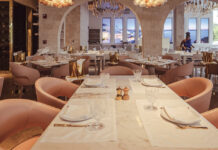Sidebar:
In the dark about bulbs?
Bad lighting can be extremely unflattering, as anyone who has been unpleasantly shocked by their reflection in a changing room mirror will know. Good lighting, on the other hand, can be a great enhancer.
Lighting design in the home is an aspect of interior design that is frequently overlooked, or thrown together as an afterthought. Well planned lighting, however, can literally transform a room. It is about far more than illumination – lighting creates mood and atmosphere.
Gone are the days when a central fan light was enough for the living room and a flickering fluorescent tube light worked in the bathroom and kitchen. Contemporary lighting design makes use of different types of light for different purposes, all of which can be layered for greater complexity. The mind-boggling array of light bulbs now available can further add subtle differences in tone.
There are three types of light, explains Sherrill Bushfield of Woods Furniture and Design, each of which has its place and function in the home. Ambient lighting, such as the recessed lights in ceilings or a central fan light, provide an overall, diffuse level of light to a room. Dimmer switches are ideal for these lights, as they allow for far more creativity.
Task lighting refers to lamps or spotlights that enable one to perform specific tasks, such as cooking, reading or writing. This could be a desk lamp, a reading light or lights under kitchen cabinets that illuminate the work surfaces.
Accent lighting is lighting that emphasizes an area or object, such as a painting. This type of lighting, although not strictly necessary, is a great way to add dramatic effect and personality to the décor.
Layering refers to the use of different lights in the same space. In entranceways with high ceilings, for example, lights positioned at varying heights can create a far more inviting atmosphere than a single chandelier.
Combining lights that send their lights upwards, with others that are directed towards the centre, or at specific decorative features all contribute to a more complex and interesting effect.
Lighting should be planned based on the activities that take place in each room. In a dining room, for example, you will want to make sure the table is well lit, possibly by lamps suspended from the ceiling. In the kitchen and bathroom, make sure the light does not come from behind you, advises Sherrill, as your body will cast a shadow over what you are doing.
The types of light bulb you choose also merit some consideration. Newer LED and CFL lights tend to cast a light that is on the cooler end of the spectrum.
This works well in rooms painted in cool blues and greys, whereas warmer wall colours need warmer light. Currently, LED lights cast their light in one direction only, making them unsuitable for lamps.
Technology in this area is progressing fast, however, and improvements are being made all the time.
With the multitude of lighting options on offer, achieving the right effect is more complex than it might first appear. Whether it’s a cosy, candlelit glow you want or the ideal light by which to paint, it is often advisable to consult a professional to ensure your vision becomes a reality.






























